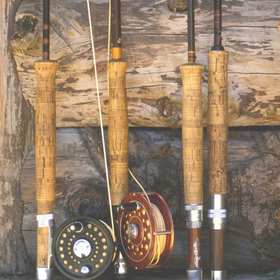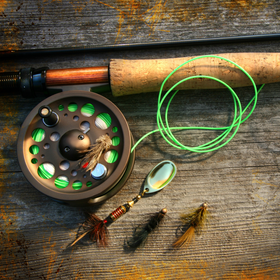Ahh, yes. Trico time, the time of year accomplished fly fisherman throw down their rods in disgust, take up the golf clubs, repaint the house, design the ninth wonder of the world. Anything but test their patience and skill against the dreaded Tricos and the super selective trout that feed on them. Called the ‘White Winged Devils’ in the gentlest of circles, these tiny micro hatches can infuriate the most skilled fly fishing angler. Huge lunker trout hunker down in feeding lanes slurping up every Trico spinner except the pattern you are offering to them. And after several hundred tedious passes, after you have lightened your tippet, after you have changed your position, after you have done everything but jump in the water and grab the fish with your bare hands, you give up in disgust, and wait for something larger and more tangible to come off the water. A nice Salmonfly hatch would be the ticket. But, alas there are ways to improve your catch rate during these prolific hatches.
About the Trico:
The Tricos are prevalent in a majority of great trout fly fishing streams from Pennsylvania to the west coast. They primarily hatch in the morning, and primarily in the summer. Although the streams of Arizona and New Mexico can have hatches in February. The Trico is tiny, this adds to the frustration of many fly fisher’s, it can be as small as size 26 hook, although they primarily are in the 18-22 range. Besides their diminutive size, they can be recognized by their lack of hind wing.
 - Tricos can be dark. The darker ones are usually referred to as males,
although this one was a female.
- Tricos can be dark. The darker ones are usually referred to as males,
although this one was a female.
On many rivers, the Trico hatch is multigenerational, lasting several months into late summer or early fall. That means that several generations hatch and die in one season. Many insect species live a year or more, but Tricos can complete a life cycle in a short time span. That means that trout see a lot of them, and a few fish get caught while eating them, making them even more selective. By far the easiest Trico fishing is the spinner fall. After the laying of the eggs, the females die in swarms and fall into the river, and then the males closely follow. Hatching usually takes place early in the morning or late at night. With the spinner falls shortly after daybreak to mid-morning.
 - Tricos can also be creamy, pale olive or tan. The females are usually
thought to be lighter in color, although that is not always true
- Tricos can also be creamy, pale olive or tan. The females are usually
thought to be lighter in color, although that is not always true
Flies:
As we stated above, spinner falls are more important than the actual hatch for fly fishing. Spinner falls happen in clusters and trout crowd into feeding lanes, and can open their mouths and inhale a multitude of flies. Here at The Big Y Fly Co. We carry Parachutes and Spinners, in both male (black) and female (cream) colors. The Parachute with their white posts are easier to see, and can be used for the hatch and the spinner fall. They also are more buoyant than the hackle-less spinner.
Fishing:
Most fish caught during the Trico hatch are taken fairly close to the angler. Accurate casts are required, especially during the spinner falls when fish congregate into small areas. If casting delicately and accurately isn’t your thing, then fishing tricos is going to be a challenge. Using slower action rods often enhances casting accuracy, and absorb much of the shock when fish strike to protect the tippets. To learn more about rod selection read:
Choosing a Fly Rod
As mentioned earlier, light tippets are the rule. Fishing tiny flies requires a drag free drift. Once hooked, fish will need to be finessed or they will break your fly off. Try to lead your fish out of the feeding lanes by pointing your rod tip down and forcing them to shore, thus spooking less fish, and getting your fish into slower water will ease its landing. We recommend going about 3 feet longer with your leader and one tippet size smaller than you would if the insects were a more typical size.
Another issue that anglers face with Tricos is that they tend to hatch and fall in calmer water, where fish can see farther through glass-clear water surfaces. This means that an angler must be extra stealthy at all times, and know that the fish will likely spook a little easier.
Since the Trico hatch is long in many areas, trout become more and more selective. During the spinner fall they will often feed on females (cream color) first and males (black) second. It often pays off to switch flies during the fall, it is often difficult to rationalize, to take the time this requires, when fish are rising everywhere. If you are fortunate enough to have two rods handy, rig them up before hitting the water.
If you are having no luck, try forcing your pattern sub-surface. This works especially well for the Trico Spinner pattern. Fish are often more vicious feeders under the water and less selective. It is often the way fly fishing novice’s catch their first trout during the Trico hatch. The Sunken Trico is a proven pattern, tied so that it will sink really slowly, it is responsible for a lot of nice fish from just under the surface during a spinner fall.
Summary:
Perhaps more than any other fly fishing experience, the Trico hatch teaches us patience, perseverance, and the joys of catching fish. Summer is a glorious time to be on the water, and the Trico hatch gives us an excuse to let that paint fade just one more year




